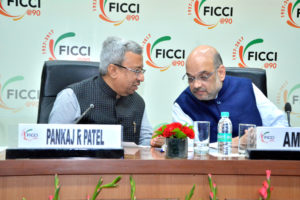BJP president Amit Shah’s economics

Pankaj Patel, president of FICCI with Amit Shah, president of BJP during the interactive session at FICCI, New Delhi
As Amit Shah, the BJP national president, gave a sermon to captains of the industry last week — to reinvent their role to promote brand India, make India a global manufacturing hub, focus on research and development, and secure more patents — his audience maintained stoic silence.
In the backdrop of widespread pain and criticism caused due to the ban of high-value notes by Indian Prime Minister Narendra Modi on November 8 last year, dismal gross domestic product (GDP) numbers and jobless growth, BJP president Amit Shah said that demonetisation was an example of a “very tough” decision.
Shah, considered to be the alter ego of Prime Minister Modi, asserted that it has led to an increase in the “formal economy” of the country.
“We have not attached policy decisions with our vote-bank. It is possible that we may face — or may have faced — some political losses for this reason. Nevertheless, by being very tough, and by understanding what is necessary to boost the economy, we have taken decisions in that direction. Demonetisation is the biggest example,” Shah said while addressing industrialists at a session of the Federation of Indian Chambers of Commerce and Industry (FICCI) in New Delhi, last Saturday.
Counting the blessings of demonetisation, Shah said since the Modi government came to power in May 2014 there has been an “increase in the number of taxpayers from 37 million to 63 million.”
No doubt, the Modi government takes tough decisions. What is important is the consequences of such decisions.
In the first quarter (April-June) of the current financial year, GDP growth fell to 5.7 pc — the lowest since the Narendra Modi-led government came to power in 2014. Economists point out that this was the consequence of the scrapping of old INR 500 and INR 1,000 notes in November 2016, which had led to a massive fall in demand.
There was a sharp decline from 7.9 pc growth seen in the same quarter last year. But Shah gave a twist to the decline in GDP by attributing it to technical reasons. Neither did Shah elaborate nor did the hundreds of captains of industry, who were assembled, seem eager to know what these technical reasons were.
On the GDP growth, Shah wondered if improving the quality of life of 12.5 million people was not part of the growth story. “If every house has a toilet, electricity and LPG cylinder, will GDP increase or not?” he asked.
But one of the factors that did not support growth as anticipated was agriculture.
The agricultural sector is estimated to have grown by 2.3 pc in real terms, year-on-year during April–June 2017. This was the lowest growth recorded by the sector in the past five quarters. It was lower than the 2.5 pc growth recorded in the previous year’s quarter.
Data from the Index of Industrial Production released on September 12, shows that factory production has grown by only 1.2 pc, while it grew at 4.5 pc the same time last year.
This only proves that industrial activity and manufacturing are still reeling under the impact of demonetisation and GST— the twin shocks unleashed on the economy by the Modi government during the last one year.
Post-demonetisation, the job losses staggered and unemployment began to mount.
According to the survey data released by the Centre for Monitoring Indian Economy (CMIE), there was a loss of roughly 1.5 million jobs. While India’s employed force grew from 401 million in April 2016 to 406.5 million in December 2016, it fell to 405 million in the four-month survey period of January through April, 2017. India’s employed labour force went up during the September–December 2016 period, and demonetisation occurred on November 8, 2016.
Mahesh Vyas, chief executive officer and managing director of the Centre for Monitoring Indian Economy observed that: “Low growth and low employment are probably helping keep consumer sentiments muted.” Household consumer sentiments continue to fall despite the first week of September being in the cusp of several festivals. Economists trace it to lack of jobs.
All these factors indicate that domestic demand conditions are still very fragile.
Looking for much-needed sharp recovery in less than 18 months ahead of the General Elections in 2019, Shah gave the captains of industry mantras to reinvent in order to stay relevant.
“FICCI’s job is not only to bring forward complaints but also to make suggestions about how to augment India’s brand value,” Shah said pointing to efforts of the Modi government during the last three years to build a ‘Brand India’ in the world. He asked the Indian industries to come forward to encash this goodwill.
His remark should also be seen in the context of how Indian businesses are not willing to bet on fresh investments post-demonetisation, which has affected the capital formation needed for the growth of manufacturing.
Turning his attention to making India a manufacturing hub, Shah wondered why India cannot manufacture solar cells, electronic hardware, and so on.
Citing the example of how Indian pharmaceuticals are making profits on the intellectual property rights registered elsewhere, Shah asked India Inc. to establish research and development consortiums on defence, electronics, and so on, where the government too could contribute.
Having heard Shah’s sermon without any murmur, it is to be seen whether Indian businesses—that follow the maxim,‘maximum profit’—are willing to spur investment or not.
With less than 18 months to go for the next General Elections in 2019, we are set to hear more such spins and suggestions.









